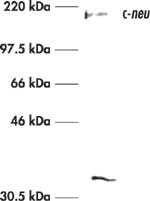OP15L Sigma-AldrichAnti-c-ErbB2/c-Neu (Ab-3) Mouse mAb (3B5)
Anti-c-ErbB2/c-Neu (Ab-3), mouse monoclonal, clone 3B5, recognizes the ~185 kDa c-ErbB2/c-Neu protein in HEK293 cells. It is validated for WB, IF, IP, and IHC on frozen and paraffin sections.
More>> Anti-c-ErbB2/c-Neu (Ab-3), mouse monoclonal, clone 3B5, recognizes the ~185 kDa c-ErbB2/c-Neu protein in HEK293 cells. It is validated for WB, IF, IP, and IHC on frozen and paraffin sections. Less<<Synonyms: Anti-HER2, Anti-Neu, Anti-ErbB2, Anti-Erythroblastosis Virus, Anti-Human Epidermal Growth Factor
Recommended Products
개요
| Replacement Information |
|---|
주요 사양표
| Species Reactivity | Host | Antibody Type |
|---|---|---|
| H, M | M | Monoclonal Antibody |
가격 및 재고여부
| 카탈로그 번호 | 재고 정보 | 패킹 | 포장 단위 | 가격(VAT 별도) | 수량 | |
|---|---|---|---|---|---|---|
| OP15L-100UGCN |
|
Glass bottle | 100 μg |
|
— |
| Product Information | |
|---|---|
| Form | Lyophilized |
| Formulation | Lyophilized from 20 mM ammonium bicarbonate Buffer, 100 µg FAF-BSA. |
| Negative control | HepG2 cells or normal skin |
| Positive control | SK-BR-3 cells or breast carcinoma tissue |
| Preservative | None |
| Quality Level | MQ100 |
| Physicochemical Information |
|---|
| Dimensions |
|---|
| Materials Information |
|---|
| Toxicological Information |
|---|
| Safety Information according to GHS |
|---|
| Safety Information |
|---|
| Product Usage Statements |
|---|
| Packaging Information |
|---|
| Transport Information |
|---|
| Supplemental Information |
|---|
| Specifications |
|---|
| Global Trade Item Number | |
|---|---|
| 카탈로그 번호 | GTIN |
| OP15L-100UGCN | 04055977224641 |
Documentation
Anti-c-ErbB2/c-Neu (Ab-3) Mouse mAb (3B5) MSDS
| 타이틀 |
|---|
Anti-c-ErbB2/c-Neu (Ab-3) Mouse mAb (3B5) Certificates of Analysis
| Title | Lot Number |
|---|---|
| OP15L |
References
| 참고문헌 보기 |
|---|
| Mamcs, J.R., et al. 1994. Ann. Surg. 219, 332. Tetu, B., et al. 1994. Cancer 73, 2359. DiFiore, P.P., et al. 1987. Science 237, 178. Slamon, D.J., et al. 1987. Science 235, 177. Varley, J.M., et al. 1987. Oncogene 1, 423. Bargmann, C.I., et al. 1986. Nature 319, 226. Yamamoto, T., et al. 1986. Nature 319, 230. Blick, M., et al. 1984. Blood 64, 1234. Schwab, M., et al. 1984. Cold Spring Harbor Laboratory 2, 215. |
Citations
| 타이틀 | |
|---|---|
|
|








